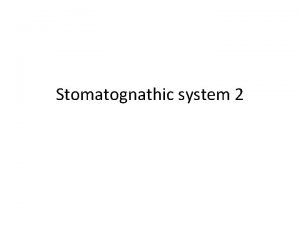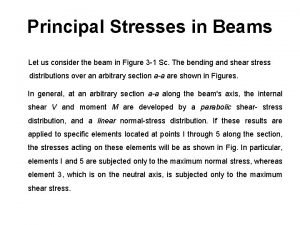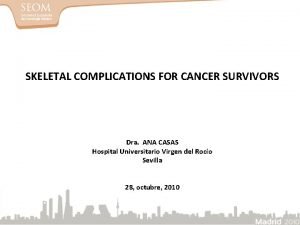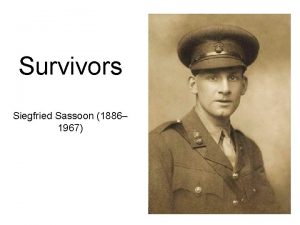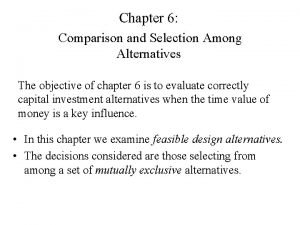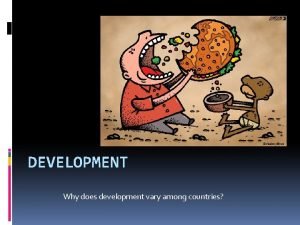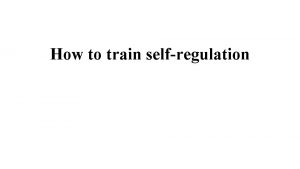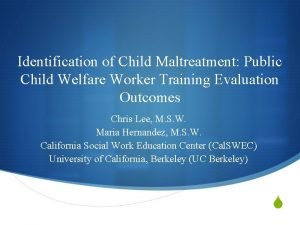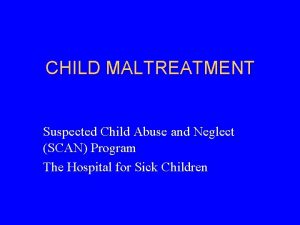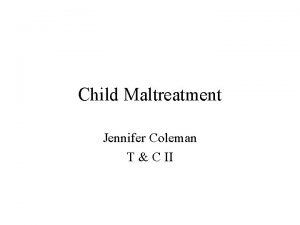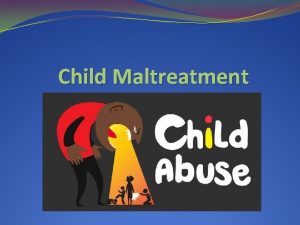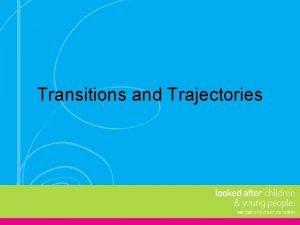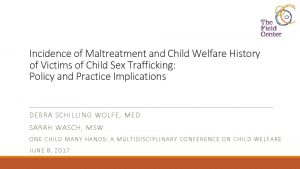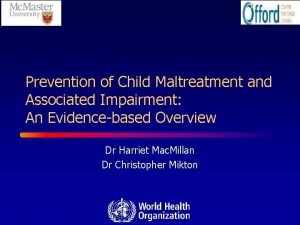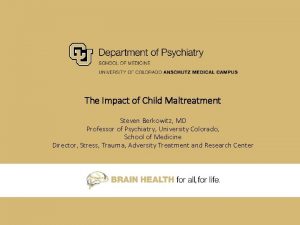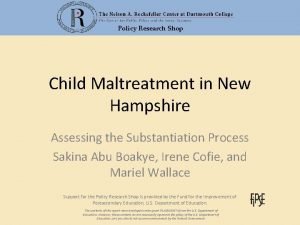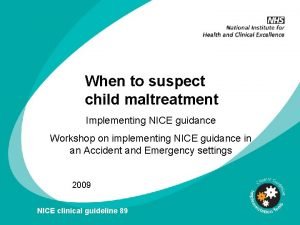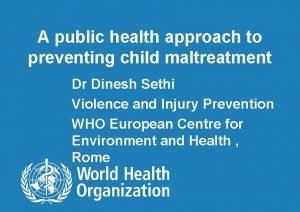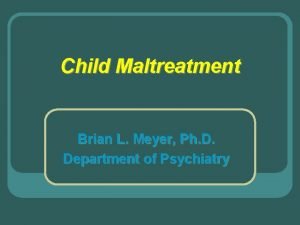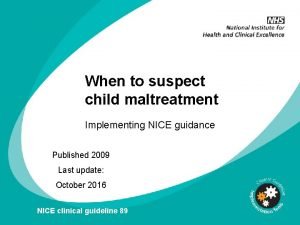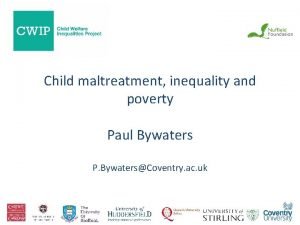Trajectories of SelfRegulation Symptoms Among Child Maltreatment Survivors























- Slides: 23

Trajectories of Self-Regulation Symptoms Among Child Maltreatment Survivors Dean Lauterbach, Ph. D. 1, Brian Allen, Psy. D 2, Stefanie Poehacker, MS 1, David Phillips, MS 1 1 Eastern 2 Penn Michigan University State College of Medicine Dlauterba@emich. edu Special thanks to the National Data Archive on Child Abuse and Neglect at Cornell University for providing access to the data

Overview Self-Regulation Emotion regulation Ability to monitor one’s affect, evaluate that affect, and modify unpleasant affect (Gratz & Roemer, 2004) Behavior regulation Ability to monitor one’s behaviors, identify how behaviors impact current affective states, and modify those behaviors appropriately (Beauchaine, 2012)

Etiology and Effect of difficulties with Self. Regulation • Etiology – May arise as a consequence of childhood maltreatment (Pollak, 2008; Shields et al. , 1994). • Effect – Self-regulation mediates the relationship between childhood maltreatment and a number of later-life variables including • Child abuse potential (Smith, Cross, Winkler, Jovanovic, & Bradley, 2014) • Emotional eating (Michopoulos et al. , 2015) • Likelihood of revictimization later in life (Dietrich, 2007)


Stability/Instability of Self-Regulation Prospective study of youth with ADHD (Biederman et al. 2012) Ø Stability Ø Change • 57% of youth with dysregulated scores at baseline remained dysregulated scores at follow up • 72% of the subjects in the “well regulated” group at baseline remained well regulated at follow up • 43% improved at follow up • 28% declined at follow up A 7 -wave epidemiological study of behavioral and emotional problems (Althoff, et al. , 2010) Ø Stability • 46% of boys and 39. 5% of girls were dysregulated in all waves Ø Change • 54% of boys and 60. 5% of girls were not dysregulated in all waves Community sample of children ages 4 to 7 (Blandon et al. , 2008) • Substantial unexplained inter-individual heterogeneity [Variances around the intercept and slope (random effects) were significantly different from zero].

Synthesis When taken together, the previous research implies the presence of 4 trajectories of self-regulation

A model that looks something like this with 4 classes

What might determine class membership? • Maltreatment – (e. g. , Kim‐Spoon, Cicchetti, & Rogosch, 2013; Kim & Cicchetti, 2010) • Severity of caregiver depression – (e. g. , Blandon et al. , 2008; Goodman et al. , 2011) However, the effect of exposure to maltreatment and parental depression on trajectory of self-regulation remains unclear.

How might class membership effect later-life psychopathology? • Difficulties with self-regulation are both coincident with and predictive of a broad range of psychopathology including: • Borderline Personality Disorder (American Psychiatric Association, 2013) • Posttraumatic Stress Disorder (Powers et al 2015; Weiss, Tull, Anestis, & Gratz, 2013) • Disruptive Mood Dysregulation Disorder (Dougherty et al. , 2014) However, the relationship between trajectory of self-regulation and later life psychopathology has not been investigated.

Goals of the present study 1. To estimate the number, size, and shape of self-regulation trajectories. 2. Test two predictors trajectory class membership: Ø Maltreatment Ø Maternal caregiver depression 3. Test the relationship between trajectory class membership and later-life PTSD symptoms. I will be using an increasingly popular technique called Growth Mixture Modeling

Growth Mixture Modeling (GMM) • Person centered • Focused on identifying the y 0 y 1 minimum number of latent class trajectories that characterize a population • • • Slope – continuous latent variable Intercept – continuous latent variable 1 1 y 2 1 1 1 y 3 1 2 3 y 4 4 0 η 1 Class – categorical latent variable Covariates • Maltreatment • Maternal depression C Distal Outcome • PTSD Sx

Current study LONGSCAN – Longitudinal Studies on Child Abuse & Neglect – Multisite study examining predictors and consequences of child maltreatment. 1. Primary growth variable - Child Behavior Checklist Dysregulation Profile (CBCL-DP). Ø Ø Sum of raw scores on three scales of the CBCL: Anxiety/Depression + Aggression + Attention Problems (Spencer et al. , 2011). o Assessed at ages 4, 6, 8, 10, 12, 14, and 16 2. Predictors Ø Ø # of maltreatment allegations (MMCS; Barnett et al. 1993) o Assessed at ages 0 to 16 Maternal Depression (CES-D; Radloff, 1977) o Assessed at age 4 3. Distal outcome variables Ø PTSD Symptoms (Trauma Symptom Inventory; Briere, 1995) o Assessed at age 18

Analysis strategy [See (Jung & Wickrama, 2008; Wang & Bodner, 2007; Wang & Wang, 2012; Wickrama, Lee, Walker, & Lorenz, 2016)] 1. Viability of a one-class model was tested 2. Test viability of models with 2 -6 classes within-class variance on growth parameters freely estimated 3. Test conditional models with covariates (predictors of class membership) Ø Used 3 -step procedure that preserves latent classes obtained in the unconditional analyses (Asparouhov & Muthén, 2014) 4. Test the relationship between group membership and later (age 18) PTSD symptoms Ø Used Lanza approach (Lanza, Tan, & Bray 2013)

Participants N = 1354 – 48. 5% boys Predictors of Class Membership Distal Outcomes ØSexual Concerns ØAnxious Arousal Ø# Maltreatment allegations o M = 46, SD = 7. 8 o M = 44, SD = 8. 8 o M = 5. 28, SD = 7. 1, o Range = 46 ØMaternal Depression o M = 12. 48, SD = 10. 93 o Range = 59 o 30. 1% having scores of 16 or more, the cutoff for possible depression ØDepression o M = 47, SD = 9. 0 ØAnger/Irritability o M = 47, SD = 10. 3 o M = 49, SD = 10. 4 o M = 50, SD = 10. 4 o M = 48, SD = 10. 3 ØIntrusive Experiences ØDefensive Avoidant ØDissociation ØDysfunctional Sexual Behavior o M = 50, SD = 10. 6 ØImpaired Self. Reference o M = 48, SD = 9. 5 ØTension Reduction Behavior Ø M = 49, SD = 10. 1

Figure 1. Unconditional 1 -class model Reasonably well-fitting model (CFI = 0. 93, TLI = 0. 94) As children age, frequency of dysregulated behaviors/emotions decreases

If we stopped the analyses here we would arrive at the wrong conclusion

Tests of models with 2, 3, 4, and 5 classes # of classes Entropy AIC 1 – 54708 A-BIC 54732 LMR-LRT CFI=. 93 BLRT TLI=. 94 posterior probabilities RMSEA=. 09 2 . 80 54494 54524 p <. 00005 . 86 -. 96 3 . 75 54422 54459 NS p <. 00005 . 71 -. 96 4 . 82 54364 54407 p <. 08 p <. 00005 . 77 -. 93 5 . 79 54304 54352 NS p <. 00005 Negative variance for slope term . 75 -. 89 6 *p <. 05, **p <. 01, *** p <. 001, **** p <. 0001

Unconditional 4 -class Linear GMM 4% 10% 7% 80%

Predictors of Latent Class Membership Maternal Depression predicted membership in the consistently high and decreasing classes relative to the consistently low class

Predictors of Latent Class Membership Maternal Depression predicted membership in the consistently high and decreasing classes relative to the increasing class

Predictors of Latent Class Membership # of Maltreatment Allegations predicted membership in the increasing class relative to the consistently low class

Prediction of distal outcomes Low vs. High Low vs. Decreasing Low vs. Increasing Anxious Arousal 12. 36**** 6. 59** 14. 82**** Depression 4. 36* 12. 23**** 14. 40**** Anger/Irritability 9. 93*** 4. 45* 21. 31**** Intrusive Experiences 3. 30 13. 09**** 22. 65**** Defensive Avoidant 0. 32 12. 39**** 27. 49**** Dissociation 4. 20* 10. 31**** 11. 63*** Sexual Concerns 9. 60*** 13. 37**** 12. 33**** Dysfunctional Sexual Behavior 5. 23* 15. 65**** 9. 34*** Impaired Self-Reference 9. 47** 12. 83**** 17. 40**** Tension-Reduction Behavior 16. 77**** 13. 07**** 9. 89** *p <. 01. ***p <. 001. ****p <. 0001

Conclusions • There is clearly heterogeneity in selfregulation over time. • • 4 -class model best fit the data There is evidence to support claims of both • stability in self-regulation over time (low and high classes) • changes in self-regulation (increasing and decreasing classes) • The most consistent predictor of membership in one of the more symptomatic selfregulation classes was maternal depression. • Membership in the more symptomatic selfregulation classes was predictive of virtually all PTSD symptoms relative to those in the low class. • Efforts to support caregivers and ameliorate depressive symptoms may have multiple down stream effects including the improvement in self-regulation skills in their children and reduction in later-life PTSD symptoms.
 What is buccinator mechanism
What is buccinator mechanism Missiles have predetermined trajectories
Missiles have predetermined trajectories Orthogonal trajectories
Orthogonal trajectories Principal stress trajectories
Principal stress trajectories 5 major technological trajectories
5 major technological trajectories Do you still get period cramps when pregnant
Do you still get period cramps when pregnant Calciphylaxis survivors
Calciphylaxis survivors Dra survivors
Dra survivors Desert animals australia
Desert animals australia Survivors teaching students
Survivors teaching students Siegfried sassoon survivors
Siegfried sassoon survivors 승자트리
승자트리 The degree of agreement among several measurements
The degree of agreement among several measurements Key issue 3: why do individual languages vary among places?
Key issue 3: why do individual languages vary among places? Individual and group decision making
Individual and group decision making Thinking, language and intelligence psychology summary
Thinking, language and intelligence psychology summary A parallelogram is a trapezoid always sometimes never
A parallelogram is a trapezoid always sometimes never Comparison and selection among alternatives
Comparison and selection among alternatives Joshua 3 10
Joshua 3 10 Why does development vary among countries?
Why does development vary among countries? Who's who in american colleges and universities
Who's who in american colleges and universities Harrumphed definition
Harrumphed definition What is an intelligent sharing of power
What is an intelligent sharing of power Why do territorial conflicts arise among religious groups
Why do territorial conflicts arise among religious groups
